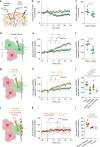Stress gates an astrocytic energy reservoir to impair synaptic plasticity
- PMID: 32332733
- PMCID: PMC7181611
- DOI: 10.1038/s41467-020-15778-9
Stress gates an astrocytic energy reservoir to impair synaptic plasticity
Erratum in
-
Author Correction: Stress gates an astrocytic energy reservoir to impair synaptic plasticity.Nat Commun. 2020 Jun 11;11(1):3064. doi: 10.1038/s41467-020-16668-w. Nat Commun. 2020. PMID: 32528004 Free PMC article.
Abstract
Astrocytes support the energy demands of synaptic transmission and plasticity. Enduring changes in synaptic efficacy are highly sensitive to stress, yet whether changes to astrocyte bioenergetic control of synapses contributes to stress-impaired plasticity is unclear. Here we show in mice that stress constrains the shuttling of glucose and lactate through astrocyte networks, creating a barrier for neuronal access to an astrocytic energy reservoir in the hippocampus and neocortex, compromising long-term potentiation. Impairing astrocytic delivery of energy substrates by reducing astrocyte gap junction coupling with dominant negative connexin 43 or by disrupting lactate efflux was sufficient to mimic the effects of stress on long-term potentiation. Furthermore, direct restoration of the astrocyte lactate supply alone rescued stress-impaired synaptic plasticity, which was blocked by inhibiting neural lactate uptake. This gating of synaptic plasticity in stress by astrocytic metabolic networks indicates a broader role of astrocyte bioenergetics in determining how experience-dependent information is controlled.
Conflict of interest statement
The authors declare no competing interests.
Figures







References
Publication types
MeSH terms
Substances
Grants and funding
LinkOut - more resources
Full Text Sources
Medical
Molecular Biology Databases
Research Materials
Miscellaneous

